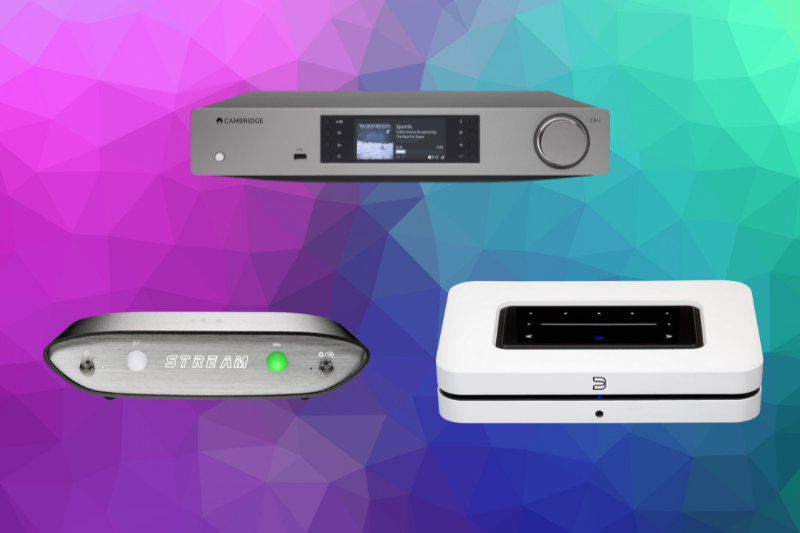Learn how to pick the best music streamer for your system!
Once derided in Audiophile circles, Network (Ethernet or Wi-Fi) Music Streamers have become an integral part of hi-fi systems. At the same time, they’re probably the most complex source you’ll come across since they have intricate network capabilities combined with the same tech present in other digital components. If you feel lost when it comes to music streamers and want to learn more about them, check out our Audiophile Music Streamers Buying Guide!
*Ad*
We have over 20 years of experience evaluating and reviewing hi-fi components, and we listen to tons of gear, so you don’t have to! If you’re looking for examples of great-sounding music streamers, then check out our Streamers Best Buys page.
What to know when buying an Audiophile Music Streamer:
Connections:
Ensure the streamer you buy has all the connections you need to integrate it into your system.
Most streamers have a set of analog outputs (RCA) to send a decoded signal out from the digital to analog converter and digital outputs (optical, coax, or both) to send out the unconverted bitstream.

Others may have an HDMI input to receive signals from a TV, and some may have additional digital/analog inputs to pull in signals from external devices. In addition, streamers like the Bluesound NODE also have a USB input to bring in signals from a laptop.
While streamers are usually used along with the wireless (Wi-Fi) network in your home, some also have wired network (Ethernet) connectors. This lets them connect directly to your network router. That helps if you have trouble getting a strong enough wireless connection to play music with.
Multi-Room Streaming Platforms/Apps:
A streamer is only as good as the software platform or app it uses in many ways. Before you buy one, you should check out the app and ensure it has all the features you want.
Full-featured platforms like BluOS and DTS Play-Fi will let you manage music libraries on several music services, play music on other devices that share the same platform and local network (multi-room), plus update settings on the device.
Other platforms simply let you play music via a proprietary player, and others only serve as a conduit to the native app of the music service you want to use.

Bluetooth/AirPlay:
If you want to make quick wireless connections from your cellphone or tablet, you may want to look for Bluetooth as a feature on your streamer. Some streamers only support the lower bandwidth BT audio codecs like SBC and AAC, while others support higher bandwidth codecs like aptX HD or LDAC (now a standard in Android) for better sound quality. Streamers like the Bluesound Node even have two-way Bluetooth to play music out to a pair of wireless headphones.
Some combination “Streamer DACs” like iFi Audio’s ZEN One Signature concentrate solely on high-quality Bluetooth music connections. Sometimes, these Bluetooth streams sound almost as good as more robust Wi-Fi streams.
If you have an Apple device, it may be nice to get a streamer with AirPlay. With AirPlay, you can make a super quick, high-quality audio connection from your iPhone or iPad.
Music Services:
This probably seems pretty obvious, but it’s worth touching on. Not all streamers support every music streaming service. That said, you want to ensure the app that comes with the device you want will connect to your service of choice. Most streamers will have native access (quality may vary) to Tidal, Qobuz, and Spotify. However, if you use other services like Deezer or Amazon Music, you probably want to check the specs carefully.
On another note, remember that streaming platform software like the BluOS app (NAD and Bluesound) will not incorporate all the features and music recommendation features provided by the Music Services’ native app. That’s why many streamers now give the option to connect directly to a service’s app through setups like TIDAL Connect and Spotify Connect or via a link from the streamer’s app. This can be a good thing since you can take advantage of personalized playlists, advanced sorting, etc.
Voice Controls:
Some streamers also respond to virtual voice assistants like Alexa and Google Assistant so that you can yell out commands like “Alexa” or “Hey Google, play me some Steely Dan,” and it will start up your streamer and play some Steely Dan.
More:
Hifitrends is reader-supported. When you purchase through links on our site, we may earn an affiliate commission. Prices are subject to change at any time.

I’m an audio writer who started as a young audio salesman/consumer electronics professional back in the late 90s. That’s where I discovered the magic of 2-Channel sound. My hunger for great sound has led me on a delightful music quest that continues today.


Leave a Reply